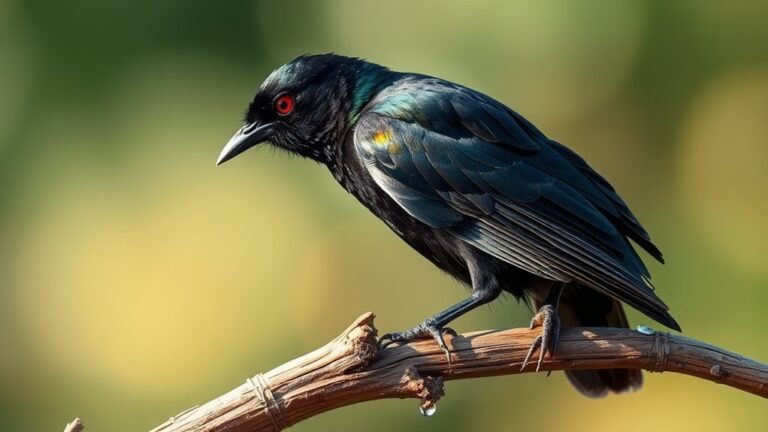What Bird Is the Symbol of the National Audubon Society?
The American Robin is the symbol of the National Audubon Society. This bird features a bright orange-red breast and signals the arrival of spring. It represents values of renewal and hope. The Robin also plays an important role in ecosystems. Understanding its significance highlights why it is closely associated with Audubon's mission. What can we learn about this remarkable bird?
Key Takeaways
The American Robin is the symbol of the National Audubon Society. This bird represents North American birds and marks the arrival of spring with its cheerful song. The robin stands for renewal and hope, reflecting stories of resilience in nature.
As a sign of environmental health, the presence of robins indicates a thriving ecosystem. The National Audubon Society works to protect robins and their habitats through various conservation efforts. They aim to ensure that these birds continue to thrive in our communities.
The Iconic Symbol: The American Robin
The American robin is a key symbol of the National Audubon Society, representing North American birds.
In spring, you can see robins energetically foraging. They hop across lawns looking for earthworms and berries. Their cheerful trills fill the morning air, marking the arrival of the season.
Watch their migration patterns. Robins travel long distances to warmer areas during winter. This journey often starts in late February when they leave their breeding grounds for the south.
Learning about these migratory routes and behaviors can enhance your appreciation for robins and help you connect with the natural cycles that define this amazing bird.
Characteristics of the American Robin
American robins have a bright orange-red breast, making them easy to identify among North American birds. They've strong bodies and cheerful songs, which reflect their active nature.
You often see them scratching the ground for worms and berries. They use their sharp eyesight to spot movement.
Robins are migratory birds. They typically return to northern areas in early spring as the season changes. Watching them travel in flocks can help you connect with nature.
Understanding their traits allows you to appreciate their beauty while recognizing their role in the ecosystem. Their presence adds to your environment, encouraging you to observe the nature around you.
Historical Significance of the American Robin
American robins are important to North American culture and history. Their bright orange breasts and cheerful songs mark the beginning of spring, representing renewal and hope.
They appear in literature, art, and folklore, symbolizing perseverance and the cycle of life. Indigenous cultures honored the American robin, linking it to various myths that emphasize resilience.
As one of the first birds to return after winter, it signals warmer weather, making it a cherished sign of the changing season. This connection to the American robin deepens your appreciation for nature and its beauty, reminding you of life's continuity in your surroundings.
Recognizing the importance of the American robin enriches your understanding of shared histories and cultural narratives.
The Role of the American Robin in Ecosystems
American robins significantly influence their ecosystems. They consume various fruits, which aids in seed dispersal. This process allows plants to grow and regenerate in habitats where birds live.
With more plant growth, biodiversity increases, supporting insects and other wildlife.
Additionally, American robins serve as indicators of environmental health. Their presence often signals a healthy ecosystem. Observing these colorful birds means witnessing an important part of nature.
Their foraging also helps control insect populations, which reduces potential pests.
Understanding the role of American robins can deepen your connection to nature. You learn to appreciate the delicate balance within ecosystems and the contributions of these birds.
Why the American Robin Represents Audubon's Mission
The American robin represents the mission of the National Audubon Society in clear and meaningful ways. This bird is a symbol of resilience and adaptability. It helps us understand the balance of our ecosystems. You can find robins in many backyards, promoting a sense of community and connection to nature.
By learning about robin nesting habits and feeding patterns, individuals can grow their conservation awareness. Every species, including the robin, plays an essential role in our environment. The robin reminds us to protect habitats to maintain biodiversity.
When you support the American robin, you support the broader mission of the Audubon Society. This effort helps to safeguard birds and their habitats. The robin isn't just a familiar sight; it's a call to action for all of us to take part in conservation.
How Audubon Society Advocates for Bird Conservation
The National Audubon Society works to protect birds through focused programs and strong partnerships.
You can support their efforts in bird conservation. Here are some ways to get involved:
- Join bird counts and surveys to gather important data.
- Attend local workshops on bird education and habitat care.
- Advocate for laws that safeguard migratory routes and habitats.
- Volunteer with Audubon to boost community conservation actions.
Together, we can make an impact on bird conservation.
Frequently Asked Questions
What Is the Lifespan of an American Robin?
An American robin usually lives about two years, but some can live up to five years. Watching robins behavior and hearing their beautiful song can help you appreciate their importance in nature.
Where Can I Find American Robins in the Wild?
To find American robins in the wild, visit gardens, parks, and open fields. Go early in the morning for the best chance to see them. Look for them in trees and shrubs, as they enjoy these habitats. Watching for their bright orange breast can help in spotting them quickly. Enjoy the experience of birdwatching and take note of their calls as you explore.
Do American Robins Migrate, and Where To?
American robins migrate seasonally. They move from their winter locations in the southern U.S. and Central America to their breeding areas in the north. This migration helps them find food and suitable breeding environments. They follow specific routes to ensure safety and reproductive success. Watching robins return in spring is a delightful sign of warmer weather.
What Do American Robins Eat?
American robins eat fruits, insects, and earthworms. They adapt their diets to their surroundings. You can see them searching for food on lawns or in trees full of berries. Their ability to find varied food sources helps them thrive in different places.
Are American Robins Common Backyard Birds?
Yes, American robins are common backyard birds. They often hop around lawns and gardens in search of insects and berries. Watching them can bring joy and a sense of connection to nature. Their cheerful songs and lively behavior make them a favorite among birdwatchers.

Kashvi is a passionate bird enthusiast and nature lover who has been fascinated by the world of birds for years. With a keen eye for detail and a love for learning, Kashvi is dedicated to sharing her knowledge and insights with fellow bird enthusiasts on Avian Enthusiasts. Through her engaging and informative articles, Kashvi aims to inspire others to join her in exploring the fascinating world of birds and to promote a deeper appreciation for these incredible creatures.







